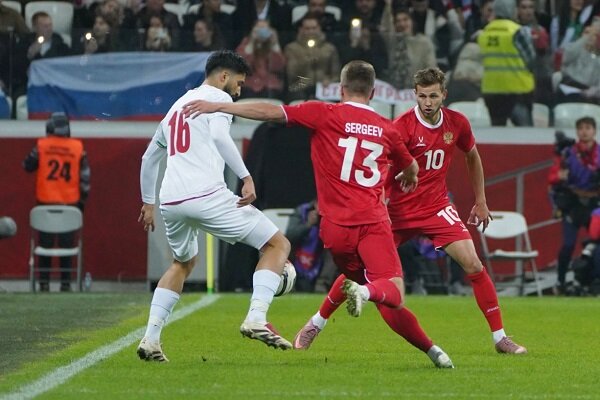Iran vs Russia: A tactical test that exposes gaps in creativity

TEHRAN - Iran’s 2–1 defeat to Russia should be seen less as a result and more as a tactical lesson. Facing a disciplined European side, Team Melli had the chance to measure themselves against World Cup-level opposition.
What emerged was a clear picture: defensive concentration can hold, resilience is present, but creativity in midfield remains the missing link.
Shape and Phases of Play
The defensive block functioned reasonably well in the first and second phases, keeping Russia’s possession in front of them. However, in transition and in Zone 14 — the central area just outside the penalty box — Iran’s pressing intensity dropped, allowing Russia to dictate rhythm and threaten with shots from distance.
In build-up, Iran often progressed through the full-backs, but the lack of a central playmaker meant circulation was slow. Without disguised passes or vertical penetration, the forwards — especially Mehdi Taremi — were too isolated, receiving the ball either with their back to goal or in wide channels rather than in true scoring positions.
Positives to Build On
Saman Ghoddos as advanced connector: His positioning between the lines was Iran’s main source of chance creation. When he received with space, Iran could accelerate.
Amirhossein Hosseinzadeh’s timing: His late runs from midfield into the box provided unpredictability, a quality Iran need more of.
Set-piece competitiveness: Corner routines showed potential, and in a World Cup environment, dead-ball efficiency can decide matches.
Weaknesses Exposed
Lack of third-man runs: The midfield offered little depth behind Taremi. Without coordinated underlaps or rotations, Russia’s defensive line was rarely stretched.
Zone 14 pressing: Too often, Russian midfielders were able to receive, turn, and strike from central positions without immediate pressure.
Predictable build-up: With Saeid Ezatolahi and Omid Noorafkan focused on ball recovery, there was no midfield profile capable of breaking lines through dribbling or incisive passing.
Why This Test Matters
Russia’s compactness, physical duels, and European tempo are exactly what Iran will encounter at the World Cup. By contrast, facing Tanzania will not replicate those conditions. These friendlies only have value if they expose weaknesses — and Russia did just that.
The Path Forward
If Iran are serious about competing on the world stage, preparation must include matches against South American opponents in the U.S. Adapting to American conditions early, and experiencing the intensity of sides like Uruguay or Colombia, would give Team Melli the tactical variety and resilience it currently lacks.
Conclusion
Iran remains competitive and resilient, but the tactical blueprint is incomplete. Without solving the creativity gap in midfield and finding ways to activate the forwards more effectively, Team Melli risk entering the World Cup with strength in structure but weakness in imagination. Nights like Volgograd are reminders: the result matters less than the lessons learned.
Leave a Comment